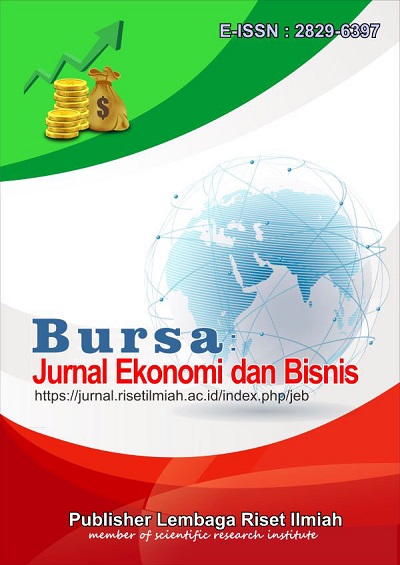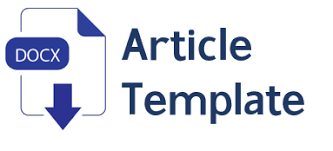Dampak Financial Fragility terhadap Finansial Well-Being: Sebuah Analisis Empiris
DOI:
https://doi.org/10.59086/jeb.v4i2.691Keywords:
Financial Fragility, Financial Well-Being, SMEs, Financial ResilienceAbstract
This study analyzes the impact of financial fragility on financial well-being among micro, small, and medium enterprises (SMEs) in Denpasar, Bali. Financial fragility refers to an individual or business's inability to withstand economic shocks, while financial well-being reflects satisfaction and security regarding one's financial condition. A qualitative approach was used, with in-depth interviews conducted with 100 SME owners. The results show that the majority of respondents experience high levels of financial fragility, as reflected in their inability to feel secure and confident in facing financial crises. Although most respondents feel satisfied with their financial condition, financial management and future planning are still lacking. This study concludes that high financial fragility can hinder the achievement of optimal financial well-being, ultimately affecting the long-term sustainability of businesses. Therefore, this research recommends enhancing financial literacy and better financial planning among SMEs to reduce financial fragility and improve their financial resilience.
References
Abdullah, M. A., Wahab, S. N. A. A., Sabar, S dan Abu, F. (2017). Factors Determining Islamic Financial Literacy Among Undergraduates. Journal of Emerging Economies & Islamic Research, 5(2), 67–76
Ainiyah, N., Deliar, A., & Virtriana, R. (2016). The classical assumption test to driving factors of land cover change in the development region of northern part of west Java. International Archives of the Photogrammetry, Remote Sensing and Spatial Information Sciences - ISPRS Archives, 41(July), 205–210. https://doi.org/10.5194/isprsarchives-XLI-B6-205-2016
Ajzen, I. (1991). The Theory of Planned Behavior. Organizational Behavior and Human Decision Processes, 50(2), 179–211.
Ajzen, I. 2005. Attitudes, Personality, and Behavior(2nd ed.). Open University Press
Barbić, D., Palić, I., & Bahovec, V. (2016). Logistic regression analysis of financial literacy implications for retirement planning in Croatia. Croatian Operational Research Review, 7(2), 319–331. https://doi.org/10.17535/crorr.2016.002
Brüggen, E. C., Hogreve, J., Holmlund, M., Kabadayi, S., & Löfgren, M. (2017). Financial well-being: A conceptualization and research agenda. Journal of business research, 79, 228-237.
CFPB. (2017). CFPB Financial Well-Being Scale. Scale Development Technical Report, May, 1– 54.
Chuah, S. C., Kamaruddin, J. N., & Singh, J. S. K. (2020). Factors Affecting Financial Management Behaviour among University Students. Malaysian Journal of Consumer and Family Economics, 25, 154–174.
Chatwani, M., & Mishra, S. K. (2021). Does financial literacy reduce financial fragility during COVID-19? The moderation effect of psychological, economic and social factors. International Journal of Bank Marketing, 39(7), 1114–1133. https://doi.org/10.1108/IJBM-11-2020-0536
Clark, R. L., Lusardi, A., & Mitchell, O. S. (2020). Financial Fragility During the Covid-19 Pandemic. SSRN Electronic Journal. https://doi.org/10.2139/ssrn.3723940
Consumer Financial Protection Bureau. (2015). Measuring Financial Well-Being: A Guide to Using the CFPB Financial Well-Being Scale. https://www.consumerfinance.gov/. https://doi.org/10.1111/joes.12124
Dijkhuizen, J., Gorgievski, M., van Veldhoven, M., & Schalk, R. (2018). Well-Being, Personal Success and Business Performance Among Entrepreneurs: A Two-Wave Study. Journal of Happiness Studies. https://doi.org/10.1007/s10902-017-9914-6
Ghasarma, R., Putri, L dan Adam, M. (2017). Financial Literacy; Strategies and Concepts in Understanding the Financial Planning With Self-EfficacyTheory and Goal SettingTheory of Motivation Approach. International Journal of Economics and Financial Issues, 7(4), 182–188
Herdjiono, I., & Damanik, L. A. (2016). Pengaruh Financial Attitude,Financial Knowledge, Parental Income Terhadap Financial Management Behavior. Jurnal Manajemen Teori
Dan Terapan| Journal of Theory and Applied Management, 9(3), 226–241.
https://doi.org/10.20473/jmtt.v9i3.3077
Hasibuan, B. K., Lubis, Y. M., and HR, W. A. 2018. Financial Literacy and Financial Behavior as a Measure of Financial Satisfaction. Advance in Economic, Business, and Management Research (AEBMR), 46, pp. 503–507.
Hung, A.A., Parker, A.M., & Yoong, J.K. .2009. “Defining and Measuring Financial Literacy”, Rand Labor And Population.
Huston, S. J. (2010). Measuring Financial Literacy. Journal of Consumer Affairs. https://doi.org/10.1111/j.1745-6606.2010.01170.x
Jasen, L., & Kim, S. S. (2023). Financial Literacy, Financial Fragility, And Financial Well- Being Among Generation-Z University Students In Indonesia. Jurnal Keuangan dan Perbankan, 27(2), 198-216.
Klapper, L., & Lusardi, A. (2020). Financial literacy and financial resilience: Evidence from around the world. Financial Management. https://doi.org/10.1111/fima.12283
Kramer, M. M. (2016). Financial literacy, confidence and financial advice seeking. Journal of Economic Behavior and Organization. https://doi.org/10.1016/j.jebo.2016.08.016
Li, J., Li, Q., & Wei, X. (2020). Financial literacy, household portfolio choice and investment return. Pacific Basin Finance Journal. https://doi.org/10.1016/j.pacfin.2020.101370
Lusardi, A. (2015). Financial literacy: Do people know the ABCs of finance? Public Understanding of Science, 24(3), 260–271. DOI: 10.1177/0963662514564516
Mandell, L., & Klein, L. S. (2007). Motivation and financial literacy. Financial Services Review.
Muir, K., Hamilton, M., Noone, J. H., Marjolin, A., Salignac, F., & Saunders, P. 2017. Exploring Financial Wellbeing in the Australian Context. Centre for Social Impact & Social Policy Research Centre - University of New South Wales Sydney, for Financial Literacy Australia, 1–58. http://www.csi.edu.au/media/Exploring_Financial_Wellbeing_in_the_Aus tralian_Context
Nababan, D., & Sadalia, I. (2012). Analisis Personal Financial Literacy Dan Financial Behavior Mahasiswa Strata I Fakultas Ekonomi Universitas Sumatera Utara. Media Informasi Manajemen, 1(1), 1–16.
Nayla, A. P., 2014, Komplet Akuntansi untuk UKM dan Waralabaǁ, Laksana, Jogjakarta
OJK. 2018. Strategi Nasional Literasi Keuangan Indonesia. Otoritas Jasa Keuangan, 1–99. https://ojk.go.id
Philippas, N. D., & Avdoulas, C. (2020). Financial literacy and financial well-being among generation-Z university students: Evidence from Greece. European Journal of Finance, 26(4–5), 360–381. https://doi.org/10.1080/1351847X.2019.1701512
Phung, Albert. 2016. Behavioral Finance. [online]. https://www.investopedia.com/university/behavioral_finance/
Rahman, M., Isa, C. R., Masud, M. M., Sarker, M., & Chowdhury, N. T. (2021). The role of financial behaviour, financial literacy, and financial stress in explaining the financial well-being of B40 group in Malaysia. Future Business Journal, 7(1), 1–18. https://doi.org/10.1186/s43093-021-00099-0
Ramli, Z., Nyirop, H. B. A., Sum, S. M., & Awang, A. H. (2022). The Impact of Financial Shock, Behavior, and Knowledge on the Financial Fragility of Single Youth. Sustainability (Switzerland), 14(8), 1–13. https://doi.org/10.3390/su14084836
Riitsalu, L. and Murakas, R. 2019. Subjective financial knowledge, prudent behavior, and income: The predictors of financial well-being in Estonia. International Journal of Bank Marketing, 37 (4), 934– 950. https://doi.org/10.1108/IJBM-03-2018-0071.
Ross et al. (2016). Pengantar Keuangan Perusahaan (Edisi Global Asia). Jakarta: Salemba Empat
Safryani, et al. 2020. Analisis Literasi Keuangan, Perilaku Keuangan, Dan Pendapatan Terhadap Keputusan Investasi. Jurnal Ilmiah Akuntansi Kesatuan, 8(3), 319-332
Sarpong-Danquah, B., Gyimah, P., Poku, K., & Osei-Poku, B. (2018). Financial Literacy Assessment on Tertiary Students in Sub-Saharan Africa: A Ghanaian Perspective. International Journal of Accounting and Financial Reporting, 8(2), 76. https://doi.org/10.5296/ijafr.v8i2.12928
Shankar, N., Vinod, S., & Kamath, R. (2022). Financial well-being – A Generation Z perspective using a Structural Equation Modeling approach. Investment Management and Financial Innovations, 19(1), 32–50. https://doi.org/10.21511/imfi.19(1).2022.03
Smithikrai, C., & Phetkham, T. (2019). Impact of Self-Contol, Financial Literacy and Financial Behavior on Financial Well-Being. Journal of Social Sciences Research, 5(1), 183–189. https://doi.org/10.32861/jssr.51.183.189
Sorgente, A., & Lanz, M. (2017). Emerging Adults’ Financial Well-being: A Scoping Review. In Adolescent Research Review (Vol. 2, Issue 4). Springer International Publishing. https://doi.org/10.1007/s40894- 016-0052-x
Taft, M. K., Hosein, Z. Z., Mehrizi, S. M. T., and Roshan, A. 2013. The Relation between Financial Literacy, Financial Wellbeing, and Financial Concerns. International Journal of Business and Management, 8 (11), 63–75. https://doi.org/doi:10.5539/ijbm. v8n11p63
Wicaksono, Edrea Divarda. (2015). Pengaruh Financial Literacy Terhadap Perilaku pembayaran Kartu Kredit Pada Karyawan di Surabaya. FINESTA. 03(01) : 85-90
Xiao, J. J., & O’Neill, B. (2016). Consumer financial education and financial capability. International Journal of Consumer Studies, 40(6), 712–721. https://doi.org/10.1111/ijcs.12285
Yap, R. J. C., Komalasari, F., & Hadiansah, I. (2018). The Effect of Financial Literacy and Attitude on Financial Management Behavior and Satisfaction The Effect of Financial Literacy and Attitude on Financial Management Behavior and Satisfaction. Jurnal Birokrasi, 23(3), 3–5. https://doi.org/10.20476/jbb.v23i3.917
Yushita, A. N. (2017). Pentingnya Literasi Keuangan Bagi Pengelolaan Keuangan Pribadi. Nominal, Barometer Riset Akuntansi Dan Manajemen, 6(1). https://doi.org/10.21831/nominal.v6i1.14330
Downloads
Published
How to Cite
Issue
Section
License
Copyright (c) 2025 Kadek Indah Kusuma Dewi, Indah, Ni Luh Putu Widhiastuti, Sagung Oka Pradnyawati, Putu Adella Febrinata

This work is licensed under a Creative Commons Attribution 4.0 International License.
You are permitted to adapt and share scientific works in this journal as well as
Commercial use

This work is licensed under a Creative Commons Attribution 4.0 International License.















